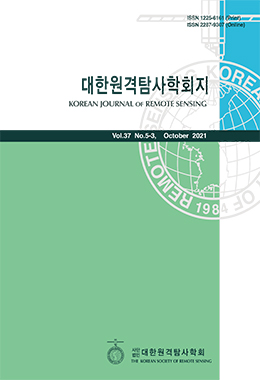갯벌 표면에는 저서성 미세조류의 생체량이 높고, 그에 따라 높은 일차생산을 나타낸다. 갯벌의 탄소순환 및 유기탄소 부존량을 추산하기 위한 일차생산력 측정 연구가 기존에 진행되어 왔지만, 최근에는 광학 원격탐사, 특히 초분광센서를 이용하는 연구는 비교적 최근에 시도되기 시작하였다. 본 연구에서는 지상에서 관측된 초분광자료를 통하여 생산성 추정의 기초자료가 되는 갯벌 표면의 엽록소 농도를 추정하는 연구를 수행하였다. 연구 대상지는 충청남도 태안군에 위치한 근소만이며, 현장조사는 2021년 4월과 6월 간조시에 수행하였다. 갯벌 표면의 초분광반사도를 얻기 위하여 지향형 센서인 TriOS RAMSES와 카메라 형태의 Specim-IQ, 두 종류의 초분광센서를 사용하였고, 광학관측자료를 통해 갯벌 표면의 엽록소-a 농도를 추정하기 위해 정규 식생지수(NDVI)와 Continuum Removal Depth(CRD)기법을 사용하였다. 현장조사시 시료분석을 통해 측정한 엽록소-a 농도와의 비교 결과, 두 기법 모두 엽록소-a 농도 약 0~150 mg/㎡의 범위에 대해 추정 결정계수 약 0.7을 달성할 수 있는 것으로 나타났다.
Mudflats are crucial for understanding the ecological structure and biological function of coastal ecosystem because of its high primary production by microalgae. There have been many studies on measuring primary productivity of tidal flats for the estimation of organic carbon abundance, but it is relatively recent that optical remote sensing technique, particularly hyperspectral sensing, was used for it. This study investigates hyperspectral sensing of chlorophyll concentration on a tidal flat surface, which is a key variable in deriving primary productivity. The study site is a mudflat in Geunso bay, South Korea and field campaigns were conducted at ebb tide in April and June 2021. Hyperspectral reflectance of the mudflat surfaces was measured with two types of hyperspectral sensors; TriOS RAMSES (directional sensor) and the Specim-IQ (camera sensor), and Normal Differenced Vegetation Index (NDVI) and Contiuum Removal Depth (CRD) were used to estimate Chl-a from the optical measurements. The validation performed against independent field measurements of Chl-a showed that both CRD and NDVI can retrieve surface Chl-a with R2 around 0.7 for the Chl-a range of 0~150 mg/㎡ tested in this study.




